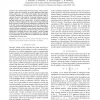Free Online Productivity Tools
i2Speak
i2Symbol
i2OCR
iTex2Img
iWeb2Print
iWeb2Shot
i2Type
iPdf2Split
iPdf2Merge
i2Bopomofo
i2Arabic
i2Style
i2Image
i2PDF
iLatex2Rtf
Sci2ools
GLOBECOM
2006
IEEE
2006
IEEE
Multicode MIMO for High Data Rate Mobile Ad-hoc Networks
Abstract—In a mobile ad-hoc network scenario, where communication nodes are mounted on moving platforms (like jeeps, trucks, tanks, etc.), use of V-BLAST requires that the number of receive antennas in a given node must be greater than or equal to the sum of the number of transmit antennas of all its neighbor nodes. This limits the achievable spatial multiplexing gain (data rate) for a given node. In such a scenario, we propose to achieve high data rates per node through multicode direct sequence spread spectrum techniques in conjunction with V-BLAST. In the considered multicode V-BLAST system, the receiver experiences code domain interference (CDI) in frequency selective fading, in addition to space domain interference (SDI) experienced in conventional V-BLAST systems. We propose two interference cancelling receivers that employ a linear parallel interference cancellation approach to handle the CDI, followed by conventional V-BLAST detector to handle the SDI, and then evaluate their...
Code Domain Interference | Domain Interference | GLOBECOM 2006 | Space Domain Interference | Telecommunications |
| Added | 11 Jun 2010 |
| Updated | 11 Jun 2010 |
| Type | Conference |
| Year | 2006 |
| Where | GLOBECOM |
| Authors | Thati Srikanth, Shamaiah Manohar, Ananthanarayanan Chockalingam, Laurence B. Milstein |
Comments (0)

